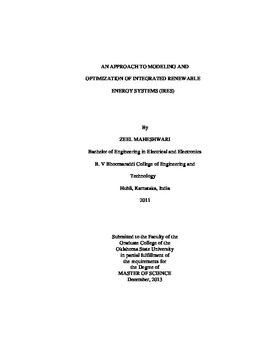| dc.contributor.advisor | Ramakumar, Rama G. | |
| dc.contributor.author | Maheshwari, Zeel | |
| dc.date.accessioned | 2015-06-17T20:06:50Z | |
| dc.date.available | 2015-06-17T20:06:50Z | |
| dc.date.issued | 2013-12-01 | |
| dc.identifier.uri | https://hdl.handle.net/11244/14981 | |
| dc.description.abstract | The purpose of this study was to cost optimize electrical part of IRES (Integrated Renewable Energy Systems) using HOMER and maximize the utilization of resources using MATLAB programming. IRES is an effective and a viable strategy that can be employed to harness renewable energy resources to energize remote rural areas of developing countries. The resource- need matching, which is the basis for IRES makes it possible to provide energy in an efficient and cost effective manner. Modeling and optimization of IRES for a selected study area makes IRES more advantageous when compared to hybrid concepts. A remote rural area with a population of 700 in 120 households and 450 cattle is considered as an example for cost analysis and optimization. Mathematical models for key components of IRES such as biogas generator, hydropower generator, wind turbine, PV system and battery banks are developed. A discussion of the size of water reservoir required is also presented. Modeling of IRES on the basis of need to resource and resource to need matching is pursued to help in optimum use of resources for the needs. Fixed resources such as biogas and water are used in prioritized order whereas movable resources such as wind and solar can be used simultaneously for different priorities. IRES is cost optimized for electricity demand using HOMER software that is developed by the NREL (National Renewable Energy Laboratory). HOMER optimizes configuration for electrical demand only and does not consider other demands such as biogas for cooking and water for domestic and irrigation purposes. Hence an optimization program based on the need-resource modeling of IRES is performed in MATLAB. Optimization of the utilization of resources for several needs is performed. Results obtained from MATLAB clearly show that the available resources can fulfill the demand of the rural areas. Introduction of IRES in rural communities has many socio-economic implications. It brings about improvement in living environment and community welfare by supplying the basic needs such as biogas for cooking, water for domestic and irrigation purposes and electrical energy for lighting, communication, cold storage, educational and small- scale industrial purposes. | |
| dc.format | application/pdf | |
| dc.language | en_US | |
| dc.publisher | Oklahoma State University | |
| dc.rights | Copyright is held by the author who has granted the Oklahoma State University Library the non-exclusive right to share this material in its institutional repository. Contact Digital Library Services at lib-dls@okstate.edu or 405-744-9161 for the permission policy on the use, reproduction or distribution of this material. | |
| dc.title | Approach to Modeling and Optimization of Integrated Renewable Energy System (Ires) | |
| dc.type | text | |
| dc.contributor.committeeMember | Hagan, Martin | |
| dc.contributor.committeeMember | Bukkapatnam, Satish | |
| osu.filename | Maheshwari_okstate_0664M_13061.pdf | |
| osu.accesstype | Open Access | |
| dc.description.department | Electrical Engineering | |
| dc.type.genre | Thesis | |
| dc.subject.keywords | energy | |
| dc.subject.keywords | integrated | |
| dc.subject.keywords | modeling | |
| dc.subject.keywords | optimization | |
| dc.subject.keywords | renewable | |
